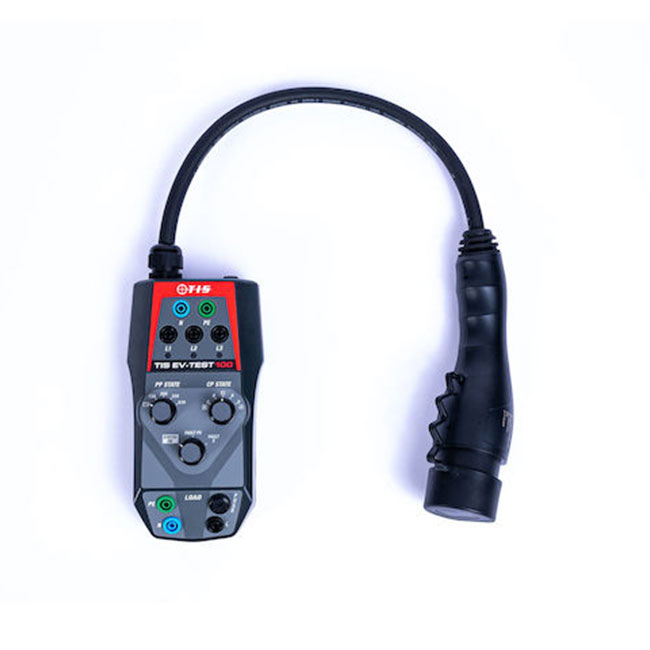A multimeter can be used by an experienced electrical technician for a wide range of electrical testing processes, such as measuring voltage, current and resistance. In recent years the evolution of electric vehicles (EVs) has seen a huge investment in charging infrastructure (Electric Vehicle Supply Equipment – or EVSE) and now we have a network of public charging stations in addition to private charging stations in workplaces and outside domestic homes.

You can use both a multimeter and a multi-function tester (our EV-TEST 100 adapter works great with the TIS MFT-PRO) for testing EVSE. Both are able to carry out this task, but the multi-function tester (such as the TIS MFTPRO-EV) has a more extended capability than a multimeter. The added advantages of the TIS MFTPRO-EV over just the multimeter are:
- Continuity test @200mA
- Insulation test of the cable
- Loop Impedance Test
- RCD testing of 'A' type & 'B' type, plus RDC DDs
- Measurements of control frequencies & voltages when introducing fault conditions.
EVs use a battery from which to draw power and this battery requires periodic charging. EVSE delivers this charge and as an item of electrical equipment in frequent use and which needs to be safe and reliable, it is an addition to the regular schedule of periodic maintenance that is required for the electrical tester.
How does EVSE test equipment work?
The idea behind EVSE test equipment is that an adapter in conjunction with an MFT acts to simulate the conditions faced by a regular EVSE charger. So, when you are running EVSE tests, the adapter & test instrument act as the vehicle and hence you don’t need an EV present.
Test Instrument Solutions supply a wide range of EVSE testing equipment, but the most popular is the EV-TEST100. This is a small handheld unit which can be linked to a multi-function tester such as the TIS MFT-Pro to carry out an auto sequence of the tests required. This test sequence simulates the various status conditions of the charger, ie. it is not delivering any charge, when it is delivering charge but is not connected to the vehicle and when it is delivering charge and is connected to the vehicle. The EV-TEST100 has a Type 2 adaptor on one end, which is the standard seven-hole charging adaptor now used throughout Europe. Importantly the EV-TEST100 will work with most other manufacturers test equipment.
Included in this auto sequence is earth and electrical fault simulation to test that the system shuts down and delivers no charge when these two common faults occur. In addition, the TIS MFTPRO & EV-TEST100 can also carry out a loop impedance tests and Type A, B RCD & RDC DD tests.
How to check the voltage output of an EVSE unit during charging
One of the ways you can check voltage output of an EVSE unit during charging is to use the EV-TEST100 adapter with the MFT-PRO:
- Connect the EV-TEST100 to the MFT-Pro using the optical lead
- The EVSE testing software should be pre-installed on the MFT-Pro (if not this can be installed separately before testing)
- When clicking on the EVSE icon the LCD screen shows you how to set-up the testing sequence for single or three-phase testing and the current rating, while the next screen shows you where to input the test leads and where the dials on the front face of the EV-TEST100 should be
- The unit carries out a continuity test first of all and shows the readings which can be saved to the unit’s memory
- Then the unit can carry out an insulation tests from 50 to 1000 volts
- When these results have been saved the unit then continues the auto sequence tests
- The first status check is the EVSE delivering no charge
- The second status check is the EVSE asking for charge but the vehicle not drawing any charge, so the results of the test should show that the EVSE is delivering current but not voltage, because the vehicle isn’t asking for it
- The third status check is where you can measure the voltage output of the EVSE during charging. The charger is ready to deliver charge and sends it to the vehicle, so the results should show both current and voltage. Here you can take a reading of the voltage output that is displayed on the LCD screen, and you can also save the results to memory
- You can then run the earth and electrical fault simulation tests which should show no current or voltage because the EVSE should shut down
- Finally, the unit will run the loop impedance, RCD & RDC DD tests to end the auto sequence of EVSE testing.
Video Demonstration
Below is a video demonstration of our MFTPRO-EV Electric vehicle charge point tester:
Please note that this section is for information purposes only. Anyone using equipment referred to in this section must be suitably qualified and/or experienced within the respective field. If in doubt before use, please consult a qualified electrician or engineer & thoroughly read all instruction booklets.